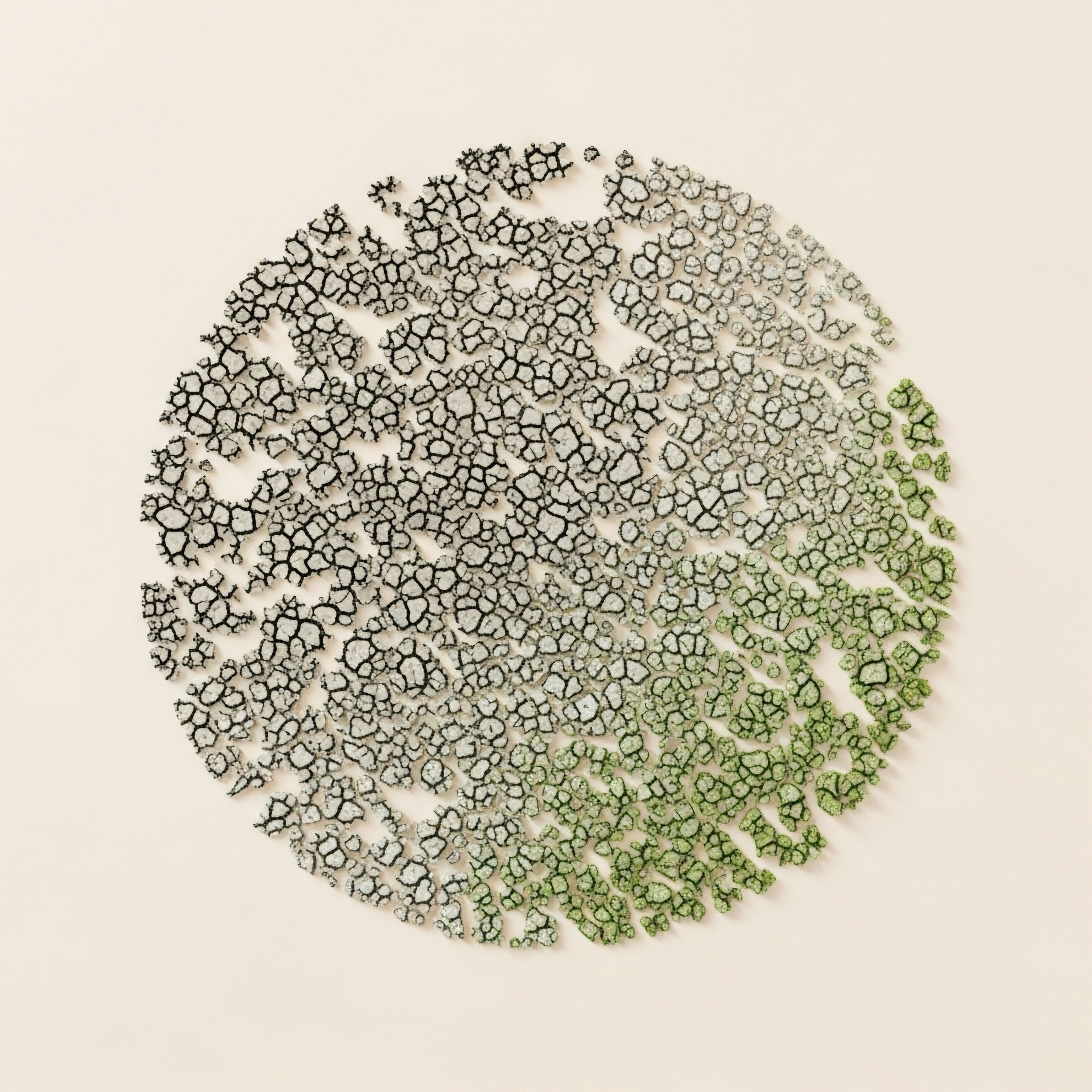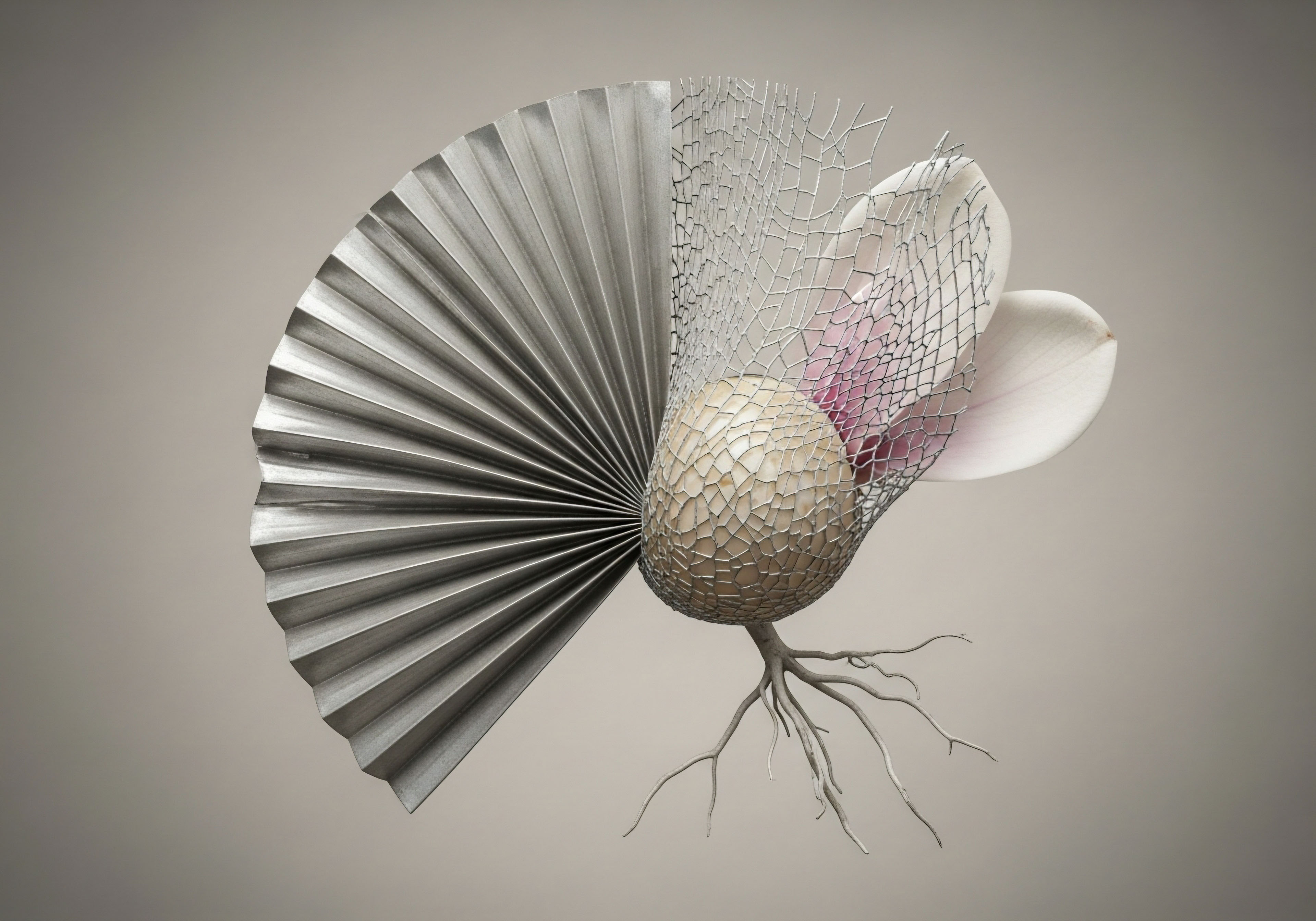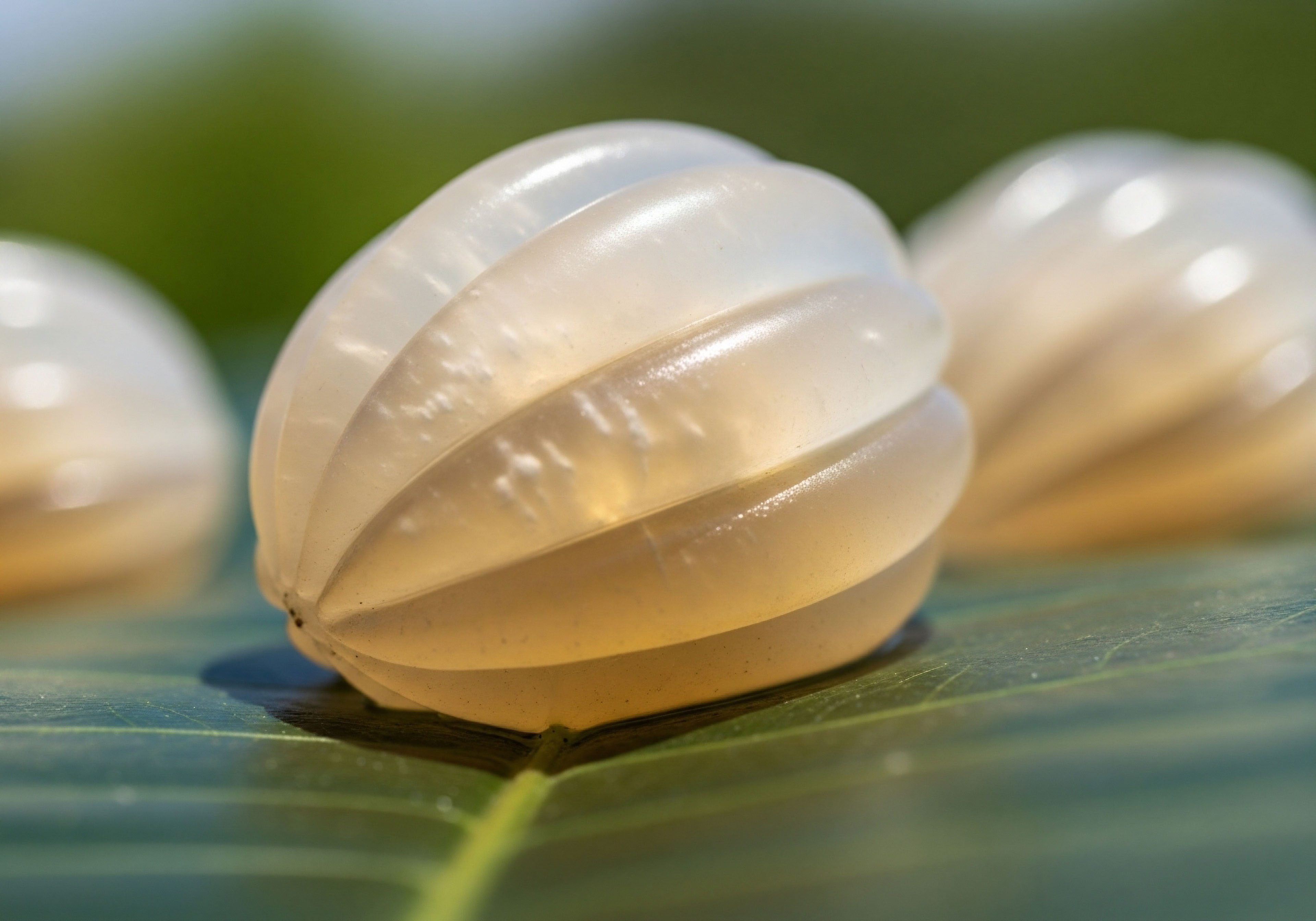

Fundamentals
You may be following a rehabilitation plan with dedication, performing every exercise and adhering to every instruction, yet the expected progress remains elusive. This experience of a recovery that has stalled, where the body seems unwilling to heal despite your best efforts, is a source of profound frustration.
The reasons for this plateau can be complex, extending deep into the body’s internal command and control system, the endocrine network. Your healing process is an active, demanding biological project. It requires a specific set of molecular resources and signals to rebuild damaged tissues. When this internal signaling system is compromised, the entire project can grind to a halt. Hormonal imbalances directly interfere with the body’s capacity to repair itself, turning a straightforward recovery into a challenging uphill battle.
Understanding this connection begins with viewing the body as a meticulously organized construction site. Rehabilitation is the process of rebuilding a damaged structure, whether it’s a torn ligament, a strained muscle, or a postsurgical site. This reconstruction requires raw materials, energy, and a clear set of blueprints.
Hormones act as the project managers and lead engineers on this site. They are the chemical messengers that travel through the bloodstream, delivering critical instructions to the cells, directing them to either build up (anabolism) or break down (catabolism). A successful rehabilitation is a profoundly anabolic state, a period of intense, focused construction.
The body’s hormonal state dictates its ability to build and repair tissue, making it a foundational element of successful rehabilitation.
Several key hormones orchestrate this process. Testosterone, often associated with male characteristics, is a powerful anabolic agent in both men and women, directly instructing muscle and connective tissue cells to synthesize new proteins and repair damage.
Estrogen, while primarily known as a female sex hormone, plays a vital role in maintaining bone density and modulating inflammation, both of which are central to orthopedic recovery. Growth Hormone (GH) and its downstream partner, Insulin-like Growth Factor 1 (IGF-1), are master coordinators of tissue regeneration, stimulating the growth and proliferation of the cells needed to mend injury. These anabolic hormones are the ‘go’ signals for your body’s construction crew.
Conversely, the body also produces hormones that can halt construction. The most significant of these is cortisol, the primary stress hormone. When the body perceives stress, whether from the injury itself, chronic pain, lack of sleep, or external life pressures, it releases cortisol.
This hormone’s primary directive in this context is to liberate energy for a fight-or-flight response. It achieves this by breaking down tissues, including muscle and collagen, and suppressing non-essential functions like repair and immunity. In the context of rehabilitation, chronically elevated cortisol acts as a persistent saboteur, constantly undermining the rebuilding efforts directed by your anabolic hormones. It creates a catabolic state where tissue breakdown outpaces tissue synthesis, making meaningful recovery nearly impossible.

The Central Command Systems
These hormonal signals do not operate in isolation. They are governed by sophisticated feedback loops originating in the brain, primarily involving the hypothalamus and the pituitary gland. Two of these systems are especially relevant to your recovery.

The Hypothalamic-Pituitary-Gonadal (HPG) Axis
The HPG axis governs the production of your primary sex hormones, testosterone and estrogen. The hypothalamus releases Gonadotropin-Releasing Hormone (GnRH), which signals the pituitary gland to release Luteinizing Hormone (LH) and Follicle-Stimulating Hormone (FSH). These hormones then travel to the gonads (testes in men, ovaries in women) and instruct them to produce testosterone or estrogen.
This system functions like a thermostat, constantly monitoring hormone levels in the blood and adjusting production to maintain a healthy equilibrium. When this axis is functioning optimally, it ensures a steady supply of the anabolic signals needed for tissue maintenance and repair.

The Hypothalamic-Pituitary-Adrenal (HPA) Axis
The HPA axis is the body’s central stress response system. When the hypothalamus detects a stressor, it releases Corticotropin-Releasing Hormone (CRH), which tells the pituitary to release Adrenocorticotropic Hormone (ACTH). ACTH then signals the adrenal glands, located atop your kidneys, to secrete cortisol.
In a healthy response, cortisol levels rise to meet a challenge and then fall once the challenge has passed. The problem in a prolonged or difficult rehabilitation is that chronic pain, inflammation, and psychological stress can keep the HPA axis persistently activated.
This leads to chronically elevated cortisol levels, which not only promotes tissue breakdown but also actively suppresses the HPG axis, reducing the output of anabolic hormones like testosterone. This creates a vicious cycle where the stress of a slow recovery further slows the recovery by creating an increasingly catabolic internal environment. Your body becomes trapped in a state of emergency, prioritizing immediate survival over long-term repair.


Intermediate
When rehabilitation progress falters, the cause often lies within the intricate molecular machinery of tissue repair and the hormonal signals that control it. A successful recovery is dependent on a series of highly coordinated cellular events ∞ inflammation management, cell proliferation, and tissue remodeling. Hormonal imbalances directly disrupt these core processes, creating specific, observable roadblocks to healing.
Understanding these mechanisms allows for a more targeted approach, moving from a general wellness strategy to a precise clinical intervention designed to recalibrate the body’s internal environment for optimal repair.
The journey from injury to full function involves the rebuilding of the extracellular matrix, the complex scaffold of proteins that gives tissues their structure and strength. The primary component of this scaffold is collagen. Hormones like testosterone are fundamental regulators of collagen synthesis.
Testosterone binds to specific androgen receptors located on fibroblasts and tenocytes, the cells responsible for producing collagen. This binding event initiates a cascade of gene transcription, effectively switching on the cellular factories that produce new collagen fibers. A deficiency in testosterone, therefore, directly translates to a reduced capacity to manufacture the primary building block of tendons, ligaments, and muscle fascia. The result is weaker, slower-healing connective tissues that are more susceptible to re-injury.

The Molecular Machinery of Repair
Beyond collagen production, hormones orchestrate the entire cellular response to injury. The process of muscle repair, for instance, is heavily dependent on a population of specialized stem cells known as satellite cells. These cells lie dormant within muscle tissue until an injury occurs.
Upon activation, they proliferate, migrate to the site of damage, and fuse with existing muscle fibers or to each other to create new ones. Growth Hormone (GH) and IGF-1 are powerful activators of these satellite cells. An environment low in these anabolic signals means fewer satellite cells are activated, and the muscle’s ability to regenerate itself is significantly impaired.
This is often experienced as a persistent weakness or an inability to regain muscle mass in a rehabilitated limb, despite consistent physical therapy.
Hormonal deficiencies can directly impair the activation of muscle stem cells, leading to incomplete recovery and persistent weakness.
Inflammation is a necessary component of the initial healing response, clearing away damaged cells and debris. An optimal hormonal environment helps ensure this inflammatory phase is potent but brief. Chronic inflammation, however, is destructive to healing. Cortisol, in its role as a stress hormone, has a complex relationship with inflammation.
While it has anti-inflammatory effects, chronically elevated cortisol levels dysregulate the immune response, leading to a state of persistent, low-grade inflammation that can degrade tissue and inhibit repair. Furthermore, sex hormones like estrogen and testosterone have immunomodulatory properties, helping to resolve inflammation efficiently. An imbalance can leave the body stuck in an inflammatory state, causing ongoing pain, swelling, and a failure to progress to the rebuilding phase of healing.

When the System Breaks down Common Scenarios
Several common clinical scenarios illustrate how these imbalances manifest and hinder rehabilitation.
- Male Hypogonadism ∞ Men experiencing age-related decline in testosterone (andropause) or clinical hypogonadism often find that orthopedic injuries heal with excruciating slowness. A torn rotator cuff or Achilles tendinopathy may become a chronic, nagging issue because the fundamental anabolic signal required for robust collagen repair is insufficient. The muscle atrophy that accompanies low testosterone further destabilizes the joint, increasing the risk of further injury.
- Perimenopause and Menopause ∞ Women in this transition experience significant fluctuations and eventual decline in estrogen and progesterone, alongside a more gradual decline in testosterone. The drop in estrogen can affect bone density, making stress fractures a greater risk during rehabilitation for other injuries. The loss of testosterone impacts muscle mass and collagen health, while shifts in progesterone can affect sleep and mood, indirectly increasing cortisol through the HPA axis. This complex hormonal shift can make recovery from even minor injuries a prolonged and frustrating process.
- Chronic Stress and HPA Axis Dysfunction ∞ An individual of any age or gender can suffer from HPA axis dysfunction due to chronic pain from the injury, poor sleep, psychological stress, or overtraining. The resulting high cortisol levels create a powerfully catabolic state. This not only breaks down existing tissue but also suppresses the HPG axis, lowering testosterone and further compromising the body’s ability to build and repair. This is the physiological basis for the feeling of “running on empty,” where the body simply lacks the resources to heal.

Clinical Protocols for System Recalibration
Addressing these imbalances requires precise, medically supervised protocols designed to restore the body’s anabolic potential. These interventions are a form of biochemical recalibration, providing the necessary signals to allow the body’s innate healing processes to function as intended.

Testosterone Replacement Therapy TRT for Men
For men with diagnosed hypogonadism hindering their recovery, a standard protocol is designed to restore physiological testosterone levels and manage its metabolic byproducts. This is about providing the body with the necessary tools for anabolism.
| Component | Typical Administration | Purpose |
|---|---|---|
| Testosterone Cypionate | Weekly intramuscular injection | The primary anabolic agent; restores testosterone to optimal physiological levels to drive muscle and collagen synthesis. |
| Gonadorelin | Twice-weekly subcutaneous injection | Mimics GnRH to stimulate the pituitary, maintaining testicular function and preserving the natural HPG axis signaling. |
| Anastrozole | Twice-weekly oral tablet | An aromatase inhibitor that controls the conversion of testosterone to estrogen, preventing potential side effects like water retention. |
| Enclomiphene | Optional oral tablet | Can be used to directly stimulate the pituitary to produce more LH and FSH, further supporting the natural hormonal axis. |

Hormonal Support for Women
For women, particularly in the perimenopausal and postmenopausal stages, hormonal support is tailored to their specific needs, focusing on symptom relief and restoring a favorable environment for tissue health.
| Component | Typical Administration | Purpose |
|---|---|---|
| Testosterone Cypionate | Low-dose weekly subcutaneous injection | Restores testosterone for benefits to libido, energy, cognitive function, and crucially, for maintaining muscle mass and collagen integrity during rehabilitation. |
| Progesterone | Oral or topical, based on cycle | Supports sleep, mood, and balances the effects of estrogen. Its use is critical for uterine health in women who have not had a hysterectomy and are also on estrogen. |
| Pellet Therapy | Subdermal implant every 3-5 months | A long-acting delivery method for testosterone, providing steady-state hormone levels without the need for frequent injections. |

Growth Hormone Peptide Therapy
For individuals who could benefit from enhanced GH and IGF-1 levels without direct GH injection, peptide therapy offers a sophisticated approach. These peptides are secretagogues, meaning they signal the body’s own pituitary gland to produce and release more growth hormone. This method preserves the natural pulsatile release of GH, which is often considered a safer and more physiologically harmonious approach.
- Sermorelin ∞ A shorter-acting peptide that mimics Growth Hormone-Releasing Hormone (GHRH), stimulating a natural pulse of GH from the pituitary.
- Ipamorelin / CJC-1295 ∞ A popular combination where CJC-1295, a GHRH analogue, provides a steady elevation in the baseline of GH, while Ipamorelin, a ghrelin mimetic, induces a strong, clean pulse of GH release without significantly affecting cortisol or prolactin. This combination is highly effective for promoting tissue repair, improving sleep quality, and enhancing recovery.
- Tesamorelin ∞ A potent GHRH analogue specifically studied for its ability to reduce visceral adipose tissue, which can also improve overall metabolic health and reduce systemic inflammation, indirectly aiding rehabilitation.
These clinical strategies are designed to correct the underlying hormonal deficits that impede healing. By restoring a robust anabolic environment, they empower the body to execute the complex task of rehabilitation effectively, turning a stalled recovery into a story of successful reconstruction.


Academic
The success or failure of a patient’s rehabilitation is determined at a fundamental level by the prevailing biochemical state of their internal environment. While mechanical loading and therapeutic exercise provide the necessary stimuli for tissue adaptation, the capacity of the musculoskeletal system to respond to these stimuli is governed by the intricate and often antagonistic relationship between the body’s primary stress and anabolic axes.
A deep analysis of rehabilitation outcomes reveals that the interplay between the Hypothalamic-Pituitary-Adrenal (HPA) axis and the Hypothalamic-Pituitary-Gonadal (HPG) axis is a critical determinant of healing. Chronic activation of the HPA axis, a common feature in patients with significant injury and pain, exerts a potent suppressive effect on the HPG axis, inducing a state of functional hypogonadism and creating a catabolic milieu that directly antagonizes the anabolic processes essential for tissue regeneration.

The HPA HPG Axis Crosstalk a Central Governor on Repair
The physiological response to trauma, surgery, or chronic pain is characterized by sustained activation of the HPA axis. The resultant hypercortisolemia is an adaptive response intended to mobilize glucose, modulate immune function, and maintain hemodynamic stability. However, when this state becomes chronic, its consequences for tissue repair are profoundly negative.
Cortisol exerts its catabolic effects through multiple mechanisms. It promotes muscle proteolysis by upregulating the ubiquitin-proteasome pathway, actively breaking down contractile proteins to supply amino acids for gluconeogenesis. In connective tissues, cortisol directly inhibits the proliferation and activity of fibroblasts, the cells responsible for synthesizing the collagenous matrix of tendons and ligaments. It also downregulates the expression of Type I collagen genes, further impairing the production of the structural backbone of these tissues.
The suppressive influence of the HPA axis extends directly to the HPG axis. Elevated levels of corticotropin-releasing hormone (CRH) and cortisol have been shown to inhibit the release of Gonadotropin-Releasing Hormone (GnRH) from the hypothalamus.
This upstream suppression reduces the pituitary secretion of Luteinizing Hormone (LH), leading to decreased testosterone production from the Leydig cells in the testes and the ovaries. The result is a state of centrally-mediated hypogonadism. This condition is not merely a bystander; it is an active contributor to poor rehabilitation outcomes.
Testosterone is a potent anabolic hormone that directly counteracts many of cortisol’s catabolic effects. It promotes muscle protein synthesis via the mTORC1 signaling pathway and stimulates collagen production through direct action on androgen receptors expressed in fibroblasts. Therefore, the stress-induced suppression of testosterone removes one of the body’s most important endogenous defenses against the catabolic state, tilting the net balance of tissue metabolism firmly toward degradation over synthesis.

What Is the Cellular Mechanism of Hormonal Action?
The impact of this hormonal imbalance is observable at the cellular and molecular levels within the healing tissues. For a tendon to repair, tenocytes must proliferate, migrate to the injury site, and deposit a new collagen matrix. This process is highly dependent on a favorable growth factor environment.
Testosterone and Growth Hormone (GH) are primary drivers of this environment, largely through their influence on Insulin-like Growth Factor 1 (IGF-1). Both hormones stimulate the local production of IGF-1 in musculoskeletal tissues. IGF-1 is a powerful mitogen and survival factor for tenocytes and fibroblasts, and it promotes the synthesis of matrix proteins.
In a state of HPA-axis-driven hypogonadism, the reduced levels of testosterone and potentially blunted GH secretion lead to a deficit in local IGF-1 signaling, starving the healing tissue of a critical stimulus for regeneration.
In women, the role of estrogen adds another layer of complexity. Estrogen receptors are present in bone, cartilage, and connective tissues. Estrogen is known to regulate bone homeostasis by suppressing osteoclast activity and promoting osteoblast survival.
In the context of orthopedic rehabilitation, particularly after fractures or joint surgery, the decline in estrogen during menopause can lead to accelerated bone loss and impaired integration of orthopedic hardware. Furthermore, estrogen has a regulatory role in collagen metabolism.
Some studies suggest that the higher incidence of certain ligamentous injuries (like ACL tears) in female athletes may be linked to cyclical fluctuations in estrogen levels that affect collagen structure and ligamentous laxity. During a prolonged rehabilitation, a state of low estrogen can contribute to suboptimal healing of both bone and soft tissues.

How Do Advanced Interventions Modulate These Pathways?
Modern therapeutic protocols are increasingly designed to directly intervene in these neuroendocrine pathways to shift the body from a catabolic to an anabolic state. These interventions are a form of applied endocrinology aimed at optimizing the internal environment for repair.
- Peptide-Based GH Axis Stimulation ∞ Direct administration of recombinant human growth hormone (rhGH) can have significant side effects and disrupt the natural feedback loops of the GH axis. Peptide therapies like the combination of CJC-1295 and Ipamorelin represent a more nuanced approach. CJC-1295 is a GHRH analogue with a long half-life that elevates the basal level of GH, while Ipamorelin is a selective ghrelin receptor agonist (a GH secretagogue) that induces a strong, clean pulse of GH release from the pituitary. This dual action more closely mimics the body’s natural patterns of GH secretion. The resulting increase in GH and, subsequently, systemic and local IGF-1 levels can significantly enhance satellite cell activation for muscle repair and fibroblast activity for collagen synthesis, directly supporting the goals of rehabilitation.
- Targeted Tissue Repair Peptides ∞ Beyond systemic hormonal modulation, certain peptides offer more localized effects. While research is ongoing, peptides like BPC-157 (often discussed in the context of tissue repair, similar to the prompt’s reference to PDA or Pentadeca Arginate) are thought to promote healing through mechanisms like angiogenesis (the formation of new blood vessels), which is critical for supplying nutrients and oxygen to the injury site. They may also modulate local inflammatory responses and enhance the migration of fibroblasts. These agents represent a frontier in rehabilitation science, aiming to provide targeted pro-healing signals directly at the site of injury.
- Post-TRT and Fertility Protocols ∞ For men who have been on TRT and wish to restore their endogenous HPG axis function, or for those with secondary hypogonadism, specific protocols are employed. These protocols use agents like Clomiphene Citrate (Clomid) and Tamoxifen, which are Selective Estrogen Receptor Modulators (SERMs). By blocking estrogen receptors in the hypothalamus and pituitary, they prevent the negative feedback signal that estrogen exerts, tricking the brain into thinking hormone levels are low. This leads to an increased production of GnRH and, consequently, LH and FSH, stimulating the testes to produce testosterone and sperm. Gonadorelin is also used in this context to provide a direct, pulsatile stimulation to the pituitary, further encouraging the reawakening of the HPG axis. This demonstrates a sophisticated understanding of the neuroendocrine feedback loops that govern hormonal production.
In conclusion, a comprehensive approach to challenging rehabilitation cases requires a clinical perspective that extends beyond the site of injury to the systemic neuroendocrine environment of the patient. The antagonistic relationship between the HPA and HPG axes provides a clear, evidence-based framework for understanding why some patients fail to progress.
By identifying and addressing the catabolic state induced by chronic stress and resultant hormonal deficiencies, clinicians can use targeted interventions to restore an anabolic milieu. This biochemical recalibration is often the missing element required to unlock the body’s full potential for healing and ensure a successful return to function.

References
- West, D. W. & Phillips, S. M. (2010). Anabolic processes in human skeletal muscle ∞ restoring the identities of growth hormone and testosterone. The Physician and Sportsmedicine, 38(3), 97-104.
- Rasmussen, L. H. et al. (2019). Local Growth Hormone Therapy for Pressure Ulcer Healing on a Human Skin Mouse Model. Journal of Clinical Medicine, 8(9), 1332.
- Mendias, C. L. et al. (2020). Human Growth Hormone to Prevent Muscle Weakness After Anterior Cruciate Ligament Reconstruction ∞ A Randomized, Double-Blind, Placebo-Controlled Trial. The American Journal of Sports Medicine, 48(9), 2131-2139.
- Maffulli, N. & Oliva, F. (2016). Hormones and tendinopathies ∞ the current evidence. Journal of Orthopaedic Surgery and Research, 11(1), 90.
- Prockop, D. J. & Kivirikko, K. I. (1995). Collagens ∞ molecular biology, diseases, and potentials for therapy. Annual Review of Biochemistry, 64, 403-434.
- Bhasin, S. et al. (2010). Testosterone therapy in men with androgen deficiency syndromes ∞ an Endocrine Society clinical practice guideline. The Journal of Clinical Endocrinology & Metabolism, 95(6), 2536-2559.
- Herbst, K. L. & Bhasin, S. (2004). Testosterone action on skeletal muscle. Current Opinion in Clinical Nutrition and Metabolic Care, 7(3), 271-277.
- Dickerson, S. S. & Kemeny, M. E. (2004). Acute stressors and cortisol responses ∞ a theoretical integration and synthesis of laboratory research. Psychological Bulletin, 130(3), 355 ∞ 391.
- Kurtz, R. B. et al. (2019). Systemic administration of IGF-I enhances healing in collagenous extracellular matrices ∞ evaluation of loaded and unloaded ligaments. Journal of Orthopaedic Research, 27(1), 84-91.
- Chen, Z. et al. (2021). Exercise Promotes Tissue Regeneration ∞ Mechanisms Involved and Therapeutic Scope. International Journal of Molecular Sciences, 22(16), 8589.

Reflection
The information presented here provides a map of the intricate biological landscape that governs your body’s ability to heal. It connects the tangible experience of a difficult recovery to the invisible, yet powerful, world of endocrine signaling. This knowledge is the first step.
It transforms the feeling of being stalled into an understanding of a specific physiological state, a state that can be assessed and potentially modulated. Your personal health journey is unique, written in the language of your own biochemistry. The path forward involves translating this general scientific understanding into a personalized strategy.
This requires a partnership with clinical expertise to read your body’s specific signals, to understand your unique hormonal signature, and to determine what support your system may need to fully engage in the work of rebuilding. The potential to move forward, to break through the plateau, begins with this deeper awareness of the systems that silently direct your recovery.



